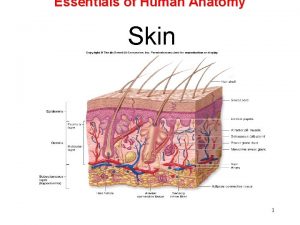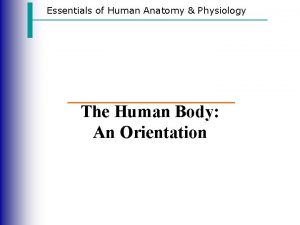Essentials of Human Anatomy Physiology Chapter 4 Skin



























- Slides: 27

Essentials of Human Anatomy & Physiology Chapter 4 Skin and Body Membranes Copyright © 2003 Pearson Education, Inc. publishing as Benjamin Cummings

Skin and Body Membranes · Function of body membranes · Line or cover body surfaces · Protect body surfaces · Lubricate body surfaces Copyright © 2003 Pearson Education, Inc. publishing as Benjamin Cummings Slide 4. 1

Classification of Body Membranes · Epithelial membranes · Cutaneous membrane · Mucous membrane · Serous membrane · Connective tissue membranes Copyright © 2003 Pearson Education, Inc. publishing as Benjamin Cummings Slide 4. 2

Cutaneous Membrane · Cutaneous membrane = skin · A dry membrane · Outermost protective boundary · Superficial epidermis · Keratinized stratified squamous epithelium · Underlying dermis · Mostly dense connective tissue Copyright © 2003 Pearson Education, Inc. publishing as Benjamin Cummings Figure 4. 1 a Slide 4. 3

Mucous Membranes · Surface epithelium · Type depends on site · Underlying loose connective tissue (lamina propria) · Lines all body cavities that open to the exterior body surface · Often adapted for absorption or secretion Copyright © 2003 Pearson Education, Inc. publishing as Benjamin Cummings Figure 4. 1 b Slide 4. 4

Serous Membranes · Surface simple squamous epithelium · Underlying areolar connective tissue · Lines open body cavities that are closed to the exterior of the body · Serous layers separated by serous fluid Figure 4. 1 c Copyright © 2003 Pearson Education, Inc. publishing as Benjamin Cummings Slide 4. 5

Serous Membranes · Specific serous membranes · Peritoneum · Abdominal cavity · Pleura · Around the lungs Figure 4. 1 d · Pericardium · Around the heart Copyright © 2003 Pearson Education, Inc. publishing as Benjamin Cummings Slide 4. 6

Connective Tissue Membrane · Synovial membrane · Connective tissue only · Lines fibrous capsules surrounding joints Copyright © 2003 Pearson Education, Inc. publishing as Benjamin Cummings Figure 4. 2 Slide 4. 7

Integumentary System · Skin (cutaneous membrane) · Skin derivatives · Sweat glands · Oil glands · Hairs · Nails Copyright © 2003 Pearson Education, Inc. publishing as Benjamin Cummings Slide 4. 8

Skin Functions · Protects deeper tissues from: · Mechanical damage · Chemical damage · Bacterial damage · Thermal damage · Ultraviolet radiation · Desiccation Copyright © 2003 Pearson Education, Inc. publishing as Benjamin Cummings Slide 4. 9 a

Skin Functions · Aids in heat regulation · Aids in excretion of urea and uric acid · Synthesizes vitamin D Copyright © 2003 Pearson Education, Inc. publishing as Benjamin Cummings Slide 4. 9 b

Skin Structure (3 main layers) 1. Epidermis – outer layer · Stratified squamous epithelium · Often keratinized (hardened by keratin) 2. Dermis · Dense connective tissue Copyright © 2003 Pearson Education, Inc. publishing as Benjamin Cummings Slide 4. 10 a

Skin Structure 3. Deep to dermis is the hypodermis · Not part of the skin · Anchors skin to underlying organs · Composed mostly of adipose tissue Copyright © 2003 Pearson Education, Inc. publishing as Benjamin Cummings Slide 4. 10 b

1. Layers of Epidermis · Stratum basale · Cells undergoing mitosis · Lies next to dermis · Stratum spinosum · Stratum granulosum Copyright © 2003 Pearson Education, Inc. publishing as Benjamin Cummings Slide 4. 11 a

1. Layers of Epidermis · Stratum lucidum · Occurs only in thick skin · Stratum corneum · Shingle-like dead cells Copyright © 2003 Pearson Education, Inc. publishing as Benjamin Cummings Slide 4. 11 b

2. Dermis · Two layers · Papillary layer · Projections called dermal papillae · Pain receptors · Capillary loops · Reticular layer · Blood vessels · Glands · Nerve receptors Copyright © 2003 Pearson Education, Inc. publishing as Benjamin Cummings Slide 4. 13 a

Skin Structure

Normal Skin Color Determinants · Melanin · Yellow, brown or black pigments · Carotene · Orange-yellow pigment from some vegetables · Hemoglobin · Red coloring from blood cells in dermis capillaries · Oxygen content determines the extent of red coloring Copyright © 2003 Pearson Education, Inc. publishing as Benjamin Cummings Slide 4. 14

Appendages of the Skin · Sebaceous glands · Produce oil · Lubricant for skin · Kills bacteria · Most with ducts that empty into hair follicles · Glands are activated at puberty Copyright © 2003 Pearson Education, Inc. publishing as Benjamin Cummings Slide 4. 15

Appendages of the Skin · Sweat glands · Widely distributed in skin · Two types · Eccrine · Open via duct to pore on skin surface · Apocrine · Ducts empty into hair follicles Copyright © 2003 Pearson Education, Inc. publishing as Benjamin Cummings Slide 4. 16

Sweat and Its Function · Composition · Mostly water · Some metabolic waste · Fatty acids and proteins (apocrine only) · Function · Helps dissipate excess heat · Excretes waste products · Acidic nature inhibits bacteria growth · Odor is from associated bacteria Copyright © 2003 Pearson Education, Inc. publishing as Benjamin Cummings Slide 4. 17

Skin Homeostatic Imbalances · Infections · Athletes foot · Caused by fungal infection · Boils and carbuncles · Caused by bacterial infection · Cold sores · Caused by virus Copyright © 2003 Pearson Education, Inc. publishing as Benjamin Cummings Slide 4. 23

Skin Homeostatic Imbalances · Infections and allergies · Contact dermatitis · Exposures cause allergic reaction · Impetigo · Caused by bacterial infection · Psoriasis · Cause is unknown · Triggered by trauma, infection, stress Copyright © 2003 Pearson Education, Inc. publishing as Benjamin Cummings Slide 4. 24

Skin Homeostatic Imbalances · Burns · Tissue damage and cell death caused by heat, electricity, UV radiation, or chemicals · Associated dangers · Dehydration · Electrolyte imbalance · Circulatory shock Copyright © 2003 Pearson Education, Inc. publishing as Benjamin Cummings Slide 4. 25

Rules of Nines · Way to determine the extent of burns · Body is divided into 11 areas for quick estimation · Each area represents about 9% Copyright © 2003 Pearson Education, Inc. publishing as Benjamin Cummings Slide 4. 26

Severity of Burns · First-degree burns · Only epidermis is damaged · Skin is red and swollen · Second degree burns · Epidermis and upper dermis are damaged · Skin is red with blisters · Third-degree burns · Destroys entire skin layer · Burn is gray-white or black Copyright © 2003 Pearson Education, Inc. publishing as Benjamin Cummings Slide 4. 27

Critical Burns · Burns are considered critical if: · Over 25% of body has second degree burns · Over 10% of the body has third degree burns · There are third degree burns of the face, hands, or feet Copyright © 2003 Pearson Education, Inc. publishing as Benjamin Cummings Slide 4. 28
 Chapter 1 introduction to human anatomy and physiology
Chapter 1 introduction to human anatomy and physiology Chapter 1 introduction to human anatomy and physiology
Chapter 1 introduction to human anatomy and physiology Chapter 2 human reproductive anatomy and physiology
Chapter 2 human reproductive anatomy and physiology 3 layers of muscle
3 layers of muscle Holes essential of human anatomy and physiology
Holes essential of human anatomy and physiology Paratubular cyst
Paratubular cyst Anatomy and physiology ninth edition
Anatomy and physiology ninth edition Chapter 14 anatomy and physiology
Chapter 14 anatomy and physiology Anatomy and physiology chapter 8 special senses
Anatomy and physiology chapter 8 special senses Chapter 13 anatomy and physiology of pregnancy
Chapter 13 anatomy and physiology of pregnancy Anatomy and physiology chapter 2
Anatomy and physiology chapter 2 Anatomy and physiology chapter 7
Anatomy and physiology chapter 7 Chapter 14 the digestive system and body metabolism
Chapter 14 the digestive system and body metabolism Chapter 10 blood anatomy and physiology
Chapter 10 blood anatomy and physiology Anatomy and physiology chapter 15
Anatomy and physiology chapter 15 Anatomy and physiology chapter 1
Anatomy and physiology chapter 1 Holes anatomy and physiology chapter 1
Holes anatomy and physiology chapter 1 Anatomy and physiology chapter 15
Anatomy and physiology chapter 15 Pectoral girdle acetabulum
Pectoral girdle acetabulum Chapter 6 general anatomy and physiology
Chapter 6 general anatomy and physiology Cephalic cranial
Cephalic cranial Thin skin vs thick skin
Thin skin vs thick skin Thin skin vs thick skin
Thin skin vs thick skin Milady facial steps
Milady facial steps Upper respiratory tract labeled
Upper respiratory tract labeled Tattoo anatomy and physiology
Tattoo anatomy and physiology Science olympiad anatomy and physiology
Science olympiad anatomy and physiology Woody stem parts
Woody stem parts



















































